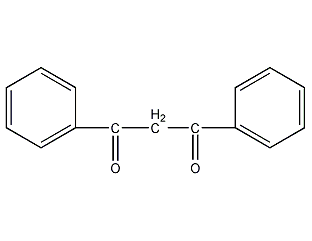
Structural formula
| Business number | 03C8 |
|---|---|
| Molecular formula | C15H12O2 |
| Molecular weight | 224.25 |
| label |
dibenzoylmethane, 1,3-diphenyl-1,3-propanedione, 1,3-Diphenylpropanedione, ω-Benzoylacetophenone, 1,3-Diphenyl-1,3-propanediamine, sensitizer, activator, Sensitizer |
Numbering system
CAS number:120-46-7
MDL number:MFCD00003085
EINECS number:204-398-9
RTECS number:TZ1930000
BRN number:514910
PubChem number:24893746
Physical property data
1. Properties: Colorless rhombic flake crystals
2. Standard heat of combustion (enthalpy) of the crystal phase (kJ·mol-1): -7393.4
3. Crystal phase standard claims heat (enthalpy) (kJ·mol-1): -224.2
4. Melting point (ºC): 80
5. Boiling point (ºC, normal pressure): 22018
6. Boiling point (ºC, 18mmHg): 219-221
7. Refractive index: Undetermined
8. Flash point (ºC): Undetermined
9. Specific rotation (º): Undetermined
10 . Autoignition point or ignition temperature (ºC): Not determined
11. Vapor pressure (mmHg, 25ºC): Not determined
12. Saturated vapor pressure (kPa, ºC): Undetermined
13. Heat of combustion (KJ/mol): Undetermined
14. Critical temperature (ºC): Undetermined
15. Critical pressure ( KPa): Undetermined
16. Log value of oil-water (octanol/water) partition coefficient: Undetermined
17. Explosion upper limit (%, V/V): Undetermined
18. Lower explosion limit (%, V/V): Undetermined
19. Solubility: Easily soluble in chlorohydrin and chloroform, soluble in sodium hydroxide solution, insoluble In sodium carbonate solution, very slightly soluble in water.
Toxicological data
1. Acute toxicity: rat oral LD50: >500mg/kg
Ecological data
Slightly harmful to water.
Molecular structure data
5. Molecular property data:
1. Molar refractive index: 65.87
2. Molar volume (cm3/mol): 196.8
3. Isotonic specific volume (90.2K): 512.9
4. Surface tension (dyne/cm): 46.0
5. Polarizability (10-24cm3): 26.11
Compute chemical data
1. Reference value for hydrophobic parameter calculation (XlogP): 3.1
2. Number of hydrogen bond donors: 0
3. Number of hydrogen bond acceptors: 2
4. Number of rotatable chemical bonds: 4
5. Number of tautomers: 2
6. Topological molecule polar surface area 34.1
7. Number of heavy atoms: 17
8. Surface charge: 0
9. Complexity: 243
10. Number of isotope atoms: 0
11. Determine the number of atomic stereocenters: 0
12. Uncertain number of atomic stereocenters: 0
13. Determine the number of chemical bond stereocenters: 0
14. Number of uncertain chemical bond stereocenters: 0
15. Number of covalent bond units: 1
Properties and stability
Avoid contact with oxides.
Storage method
Stored sealed in a cool, dry place. Make sure the workspace has good ventilation. Keep away from sources of fire and store away from oxidizing agents.
Synthesis method
It is obtained from benzylidene acetylbenzene through bromination and hydrolysis.
Purpose
Analytical reagents, determination of carbon disulfide and thallium, gravimetric determination of uranium, photometric determination of U+4, extraction of silver, aluminum, barium, beryllium, calcium, cadmium, cobalt, copper, iron, gallium, mercury, indium, lanthanum, magnesium, manganese, nickel , lead, palladium, scandium, thorium, titanium, zinc, zirconium, etc.

 微信扫一扫打赏
微信扫一扫打赏

